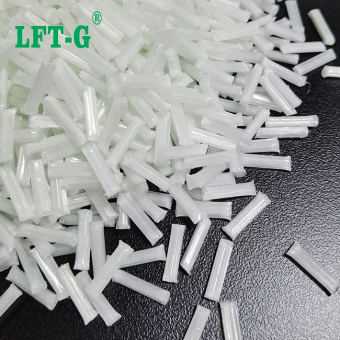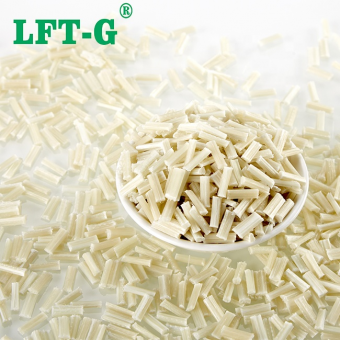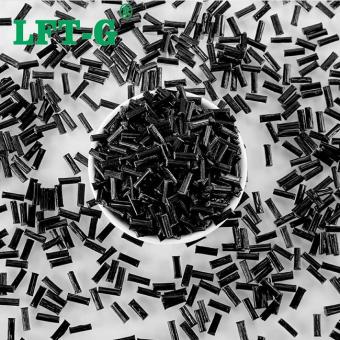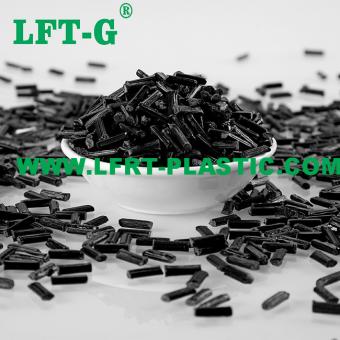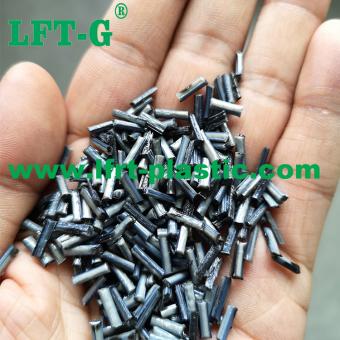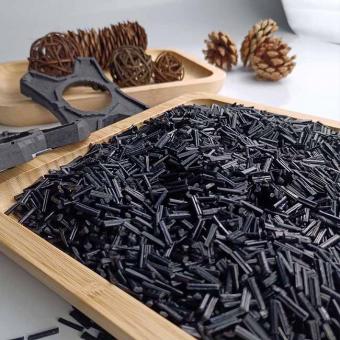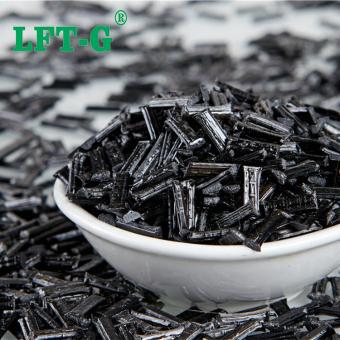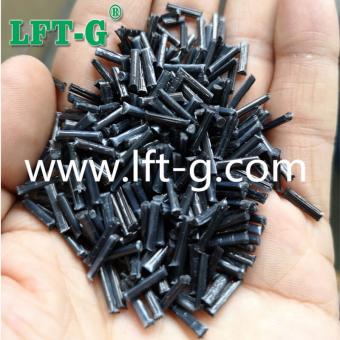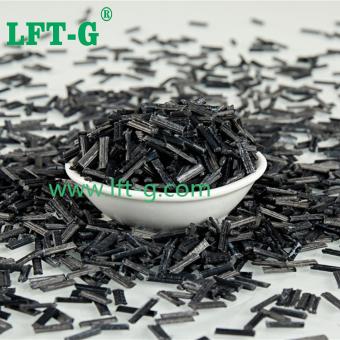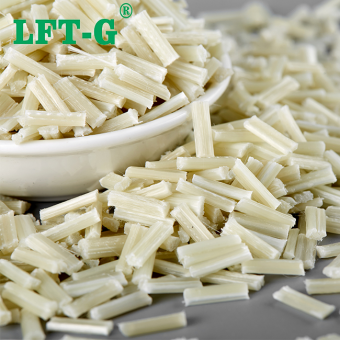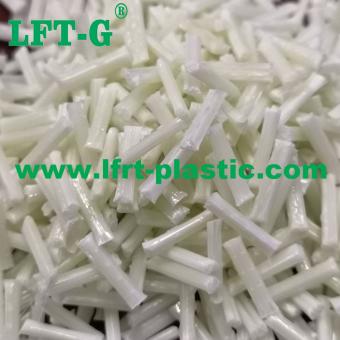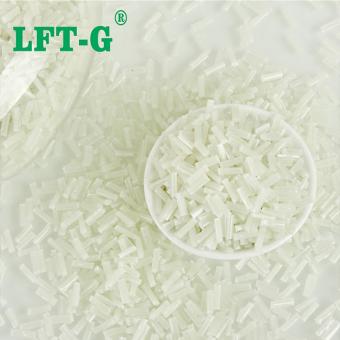-
LFT-G PP compunds filling long glass fiber polymers high rigidity low warpage instead metal for home appliance partsPP-LGF compounds Long glass fiber reinforced polypropylene composites belong to a kind of long glass fiber reinforced thermoplastics, the main preparation materials are continuous long glass fiber and polypropylene. and polypropylene. Long glass fiber reinforced polypropylene composites have longer glass fiber length, high strength, low density, high impact performance, its rigidity, strength, creep and other properties better than conventional fiber reinforced polypropylene composites. The role of glass fiber reinforced materials in glass fiber reinforced polypropylene composites is to carry loads, and the specific load-bearing properties are related to the proportion of glass fiber reinforced materials in the material, length, orientation and other factors. In the preparation process, it is found that, under the condition of unchanged preparation technology, the increase of the proportion of glass fiber reinforced material in the material will shorten the length of the material, and the bending property, tensile property, and strength of the material will be increased; when the proportion reaches 50%, the various mechanical properties of the material will reach the best. PP-LGF application In automotive engineering, instrument panels, front-end components and underbody elements are increasingly made of glass-fiber-reinforced polypropylene. Polypropylene is characterized by low density, low material costs and ease of reuse, and is therefore gradually replacing engineering plastics and metals in these applications. Glass fiber reinforced composites can significantly enhance the durability, rigidity, toughness, creep, etc. of the original material, the current glass fiber reinforced composites are increasingly widely used in automotive parts.LGF polypropylene composites can solve the traditional short glass fiber reinforced materials are easy to warp, poor low-temperature toughness, fatigue resistance is generally shortcomings such as LGF polypropylene composites, LGF polypropylene composites in the glass fiber retention length is longer, with a high specific strength, LGF polypropylene composites have longer retained glass fiber length, high specific strength, high specific modulus, strong impact resistance, dimensional stability and low warpage, etc. Therefore, LGF polypropylene materials are used to replace parts produced by traditional PA-SGF, PBT-SGF and other materials. Further weight and cost reductions are realized. LGF polypropylene can be used for engine hoods, front-end modules, instrument panel frames, tailgates, battery trays, and door liner modules. Datasheet for reference Details Grade Fiber specification Mian characteristics Applications General grade 30%-60% Chemical coupling,high strength Automobile parts, washing machine parts, water pump parts, water treatment parts, furniture, etc. Heat-resistance grade 30%-60% High strength, long-term heat aging resistance Automobile front and rear end modules, water tank frames, battery brackets, hood covers, sunroof frames, etc. UV-resistance grade 30%-60% High strength, UV resistance, long term heat aging resistance, good product appearance Car (truck) door handles, mirror systems, battery housings, truck (SUV) exterior pedals, etc. Toughten resistance grade 30%-60% Ultra-high impact strength (at normal and low temperatures) Power tools, pump housings, pipe fittings, etc. Other materials you may wonder PA6-LGF TPU-LGF PA12-LGF Frequently asked questions Q. Does long glass fiber and long carbon fiber injection have special requirements for injection molding machines and molds? A. There are certainly requirements. Especially from the product design structure, as well as the injection molding machine screw nozzle and mold structure injection molding process must consider the requirements of long fiber. Q. Using a long fiber reinforced thermoplastic material, will it block the die hole due to the long length of the fiber or not? A. When using long glass fiber or long carbon fiber, it is necessary to evaluate whether the product is suitable for LFT-G. If the product is too small or the dispensing is not suitable for long fiber materials. The long fiber itself has requirements for the mold nozzle. Q. How to choose the reinforcement method and length of the material when using long fiber reinforced thermoplastic material? A. The selection of materials depend on the requirements of the products. It is necessary to assess how much the content is enhanced and how much length is more appropriate, which are depending on the performance requirements of the products.
- Polypropylene filled lgf 30 40 50
- reinforced pp virgin grade plastic
- Low warpage electronic appliance
- PP recycled for car parts electric parts
- PP composite pellets Polymer granules
- thermoplastic resin PP with fiber
Tags :
-
LFT-G high performance PA6 Polyamide6 compounds long glass fiber instead metal original color sample availablePolyamide 66 plastic PA66 melting point 260~265℃, glass transition temperature (dry state) is 50℃. Density is 1.13~1.16 g/cm3. PA66 has low water absorption, excellent dimensional stability and high rigidity. Higher melting point, can be used for a long time in harsh environments, in a wide range of temperatures can still maintain sufficient stress, continuous use temperature of 105 ℃. Long glass fiber reinforced composite Glass fiber reinforced plastic is based on the original pure plastic, filling glass fibers and other additives, so as to improve the scope of use of the material. Generally speaking, most of the glass fiber reinforced materials are used in the structural parts of the products, which is a kind of structural engineering materials, such as: PP, ABS, PA66, PA6, TPU, PPA, PBT, PEEK, PBT, PPS and so on. Advantages 1)After glass fiber reinforcement, glass fiber is a high temperature resistant material, therefore, the heat-resistant temperature of reinforced plastics is much higher than before without glass fiber, especially nylon plastics. 2)After the glass fiber reinforcement, due to the addition of glass fiber, the plastic polymer chain is restricted to move with each other, therefore, the shrinkage of reinforced plastics decreases a lot, and the rigidity is greatly improved. 3)After glass fiber reinforced, the reinforced plastic will not stress cracking, at the same time, the impact resistance of the plastic improves a lot. 4)After the glass fiber reinforcement, the glass fiber is a high strength material, which also greatly improves the strength of the plastic, such as: tensile strength, compression strength, bending strength, improve a lot. 5)After glass fiber reinforcement, due to the addition of glass fiber and other additives, the combustion performance of the reinforced plastics decreases a lot, most of the materials can not be ignited, it is a kind of flame-retardant material. Datasheet for reference Applications PA66's comprehensive performance is good, with high strength, good rigidity, impact resistance, oil and chemical resistance, abrasion resistance and self-lubricating advantages, especially hardness, rigidity, heat resistance and creep performance is better. Datails Grade Fiber specification Main characteristics Applications General grade 20%-60% high toughness (especially at low temperatures), excellent creep and fatigue resistance, low warpage Automobiles, electronic and electrical appliances, sports equipment, power tools, high-speed rail parts, etc. Toughen resistance grade 20%-50% high impact strength, light texture Automobiles, electronic appliances, sports equipment, power tools, tool handles, high-speed rail parts, gears, etc. Lab & Factory About company Xiamen LFT Composite Plastic Co.,LTD was established in 2009, is a brand-name global suppliers of long fiber reinforced thermoplastic materials integrating product research & development(R&D), production and sale marketing. Our LFT products have passed the ISO9001&16949 system certification and have obtained lots of national trademarks and patents, covering the fields of automotive, military parts and firearms, aerospace, new energy, medical equipment, power wind energy, sports equipment, etc.
- PA66 Nylon pellets reinforced plastic
- polyamide 6 engineering plastics lgf
- Low warpage modified PA6 LGRF
- injection mold PA66 auto parts polymers
- Nylon composite pellets Polymer granules
- long glass fiber reinforced plastic pa66
Tags :
-
LFT-G Homo Polypropylene PP filling Long carbon fiber injection molding high toughness and strength compositesPP-LCF composites Polypropylene is a low-cost, excellent performance, widely used polymer materials, through the carbon fiber reinforced, can improve the strength, heat distortion temperature and dimensional stability of polypropylene materials, expanding the application of polypropylene materials, widely used in electronic and electrical appliances, automotive, construction and other fields. Especially in the automotive field, with the development of new energy vehicles and in the trend of automotive lightweight, carbon fiber reinforced materials in the automotive field is more and more widely used. Characteristics of long carbon fiber reinforced polypropylene materials Higher mechanical properties Simple production, easy molding, low warpage Lower density, lightweight, can replace steel with plastic Application The modified polypropylene material reinforced by carbon fiber has a series of advantages such as light weight, high modulus, high specific strength, low coefficient of thermal expansion, high temperature resistance, thermal shock resistance, corrosion resistance, good vibration absorption and so on, and it can be applied to automobile sub-instrument assembly and other automobile parts. Car Tool Kit Automotive front-end components More application fields, please contact us for more technical advice. Frequently asked questions 1. What are the types of thermoplastic carbon fiber composites? Carbon fiber thermoplastic composites are composites with carbon fiber as reinforcing material and thermoplastic resin as matrix. From the reinforcement of carbon fiber, it can be divided into long-cut carbon fiber (LCF)-reinforced thermoplastic composites, short-cut carbon fiber (SCF)-reinforced thermoplastic composites and continuous carbon fiber (CCF)-reinforced thermoplastic composites. Long-cut carbon fiber and short-cut carbon fiber mainly refers to the application length of carbon fiber materials, there is no strict fixed distinction between the two, generally between a few millimeters to a few centimeters, the more common specifications are 6mm, 12mm, 20mm, 30mm, 50mm. Carbon fiber thermoplastic composites can also be classified according to the thermoplastic resin, there are many common thermoplastic resins, such as PE, PP, PVC, etc., but the thermoplastic resin composites reinforced with carbon fibers are mostly used in aerospace, precision equipment, and other demanding working environments, so the carbon fiber thermoplastic composites are more commonly used in the form of polyetheretherketone (PEEK), PPS, polyimide ( Therefore, carbon fiber thermoplastic composites more often use polyether ether ketone (PEEK), PPS, polyimide (PI), polyetherimide (PAI) and other high-end thermoplastic resins as the matrix, to achieve the optimization of the material performance through the way of "strong alliance". 2. How do thermoplastic carbon fiber composites achieve low cost and environmental protection? Thermoplastic carbon fiber composites are used to make parts for high-end machinery, and they have excellent machinability, vacuum forming, stamping mold plasticity and bending processability, etc. Moreover, as long as the material reaches a certain temperature again, it can be remolded, which is recyclable and environmentally friendly in terms of the characteristics of the material itself. For example, Teijin Japan has been able to design a recycling process in the process according to the special needs, and the punched thermoplastic carbon fiber composite material trimmings are shredded, injection molded, and made into recycled materials, which can be used to make small products or injection molded nuts and studs on the carbon fiber prototype parts. This method can reduce the loss of raw materials to a greater extent, improve the use of thermoplastic carbon fiber composite materials, reduce the overall cost, so as to achieve the purpose of environmental protection. Production process of thermoplastic carbon fiber products In addition, thermoplastic carbon fiber composites, compared with thermoset carbon fiber composites, can shorten the molding cycle time due to its special process characteristics, which can further cut down the production cost in terms of production efficiency. 3. Are thermoplastic carbon fiber composites only suitable for injection molding? From the process point of view, injection molding and compression molding compared to a higher degree of automation, the raw material does not contact with the outside world, so the product appearance quality is guaranteed, there will be no black spots, impurities, uneven color and other issues, the mechanical properties of the product, dimensional stability and precision is relatively higher. At present, Toray, Japan, these carbon fiber giants in the application of carbon fiber reinforced thermoplastic composite materials, the main use of injection molding method, and this method is suitable for the production of complex shaped parts and mass production. Com...
- PP pellets lcf 30 polymer
- Long carbon fiber Reinforced Polypropylene for electrial accessories
- LFT-G xiamen compounds pp plastic resin
- PP green materials instead metal
- Polypropylene filled lcf 30 40 50
Tags :
-
LFT-G PPS composites filling long carbon fiber thermoplastic resin natural black color high rigidity for factoryPPS-LCF In carbon fiber composites, carbon fiber reinforced PPS can be said to be a very promising new material, its mechanical properties, corrosion resistance, self-flame retardant and other aspects of the performance is good, so it is often used as a matrix material for various types of high-performance composite materials. The mechanical properties of carbon fiber reinforced polyphenylene sulfide are also affected by the carbon fiber content, under a certain threshold, the larger the carbon fiber content, the stronger the ability to bear external loads. Application Through the reinforcing intervention of carbon fibers, the toughness and strength of polyphenylene sulfide PPS can be substantially increased and improved, becoming one of the most commonly used composites in the aerospace field. Compared with metal, carbon fiber reinforced PPS has the advantages of low cost and easy processing, and the cost can be reduced by 20%-50%. Used in landing gear, wings, doors, fuel tank covers, J-type nose cones, cabin trim and other parts of the aircraft, it not only helps to increase the impact resistance, high temperature resistance and corrosion resistance of these parts, but also improves the load efficiency of the aircraft and reduces fuel consumption by reducing the quality. The most representative application example is the carbon fiber reinforced polyphenylene sulfide composite material for the leading edge of the wing of Airbus A340/A380 aircraft. Datasheet Carbon fiber reinforced PPS production products, with a fast molding, easier to mass production; carbon fiber reinforced PPS with environmental standards, but also able to be used twice, in the production of the entire product as well as the processing of solvents and additives do not need to be introduced, so it can reduce or even a certain degree of avoiding environmental pollution, but also thermoplastic products, unlike thermosetting composite materials can not be reused after the molding of the product, under certain temperature conditions, it has the possibility of recycling, regeneration and reuse. Moreover, unlike thermoset composite products that cannot be reused after molding, thermoplastic products have the possibility of recycling and reuse under certain temperature conditions. In addition, relative to thermoset products, thermoplastic composite products molding speed to be faster, shorter manufacturing cycle, which is conducive to reducing the cost of products. Other materials you may wonder PPA-LCF PEEK-LCF PA12-LCF Tests & Certifications Customers & Us Frequently asked questions 1. Is there a unified reference data for carbon fiber product performance? The performance of specific carbon fiber filaments is fixed, such as Toray's carbon fiber filaments, T300, T300J, T400, T700 and so on, there are a series of parameters can be traced. However, there is no uniform standard to measure the carbon fiber composite products. Firstly, the different types of raw materials selected will lead to different performance of the products, and then due to the choice of matrix and the different design of the products, it will lead to different performance of the products. In addition to some common carbon fiber tubes, carbon fiber boards and other conventional parts, most of the carbon fiber products in the production of the sample before the test to determine whether the performance of the product is in line with the use of the expected standard, and as a base point, so as to carry out the production and use of large quantities. 2. Are carbon fiber composite products expensive? The price of carbon fiber composite products is closely related to the price of raw materials, the level of technology and the quantity of products. Some products of the industrial environment requirements are high, the performance of carbon fiber products and materials have special requirements, which requires the selection of specific raw materials, raw materials, the higher the performance of the natural price of the more expensive, such as the application of orthopedic carbon fiber PEEK thermoplastic materials. Of course, the more complex the production process, the greater t...
- Injection molded PPS reinforced plastic
- PPS made in China LCFR
- raw material pps with filler cf high performance
- Long carbon fiber Reinforced PPS for electrial accessories
- Instead metals materials PPS high performance
- thermoplastic resin PPS with fiber
Tags :
-
LFT-G PEEK high quality modified materials fill long carbon fiber for automotives good performanceThroughout the plastics industry, PEEK is widely recognized as a leading high performance polymer (HPP). However, the preferred material in the automotive, aerospace, oil and gas, and medical device industries has long been metal, and PEEK polymers are rapidly changing that mindset. What is the PEEK material PEEK or Polyetheretherketone belongs to the class of polymers known as "aromatic polyketones" (more accurately Polyaryletherketone or PAEK). Research and development of PEEK began in the 1960s, but it wasn't until 1978 that Imperial Chemical Industries (ICI) patented PEEK, and Victrex PEEK polymer was first commercialized in 1981. "Aromatic" usually implies a distinctive or sweet flavor, which may seem like an odd term, but scientists use it to describe certain molecules that contain or consist of a cyclic structure (such as the aryl unit above). Small molecules of this type, such as toluene and naphthalene, have distinctive odors and hence the name. However, PEEK itself, like most thermoplastics, is odorless under normal conditions. Chemically, PEEK is primarily a linear semi-crystalline polymer. P comes from the Greek word "poly" meaning "many", so many EEKs form PEEK. aryl and ketone groups provide stiffness by being somewhat rigid, which means good mechanical properties and a high melting point. The ether group provides a degree of flexibility, while the aryl and ketone groups are chemically inert and thus chemically resistant. The regular structure of the repeating units means that the PEEK molecule can be partially crystallized and the crystallinity provides properties such as wear resistance, creep resistance, fatigue resistance and chemical resistance. The resulting polymer is widely recognized as one of the best performing thermoplastics in the world. Compared to metals, PEEK-like materials are lightweight, easy to mold, corrosion-resistant, and have a fairly high specific strength (strength per weight). Datasheet for reference When high performance is required, PEEK as the polymer of choice offers more than just two or three properties, it offers a wide range of excellent properties including: - High heat resistance Testing has shown that LFT-G's PEEK polymer has a continuous use temperature of 260°C (500°F). This allows for a wide range of applications in hot corrosive environments such as the process industry, oil and gas industry, and the engines and transmissions of countless vehicles.PEEK resists friction and wear in dynamic applications such as thrust washers and seals. - Chemically Inert PEEK resists damage caused by chemically corrosive working environments such as downhole environments in the oil and gas industry, and gears in mechanical and automotive applications. It is resistant to jet fuels, hydraulic fluids, de-icers and pesticides used in the aerospace industry for a wide range of pressures, temperatures and time frames. - Strong mechanical properties PEEK exhibits excellent strength and stiffness over a wide range of temperatures, and the specific strength of PEEK-like carbon fiber composites is many times higher than that of metals and alloys. "Creep" is the permanent deformation of a material under constant stress over a period of time. "Fatigue" is the brittle destruction of a material under repeated cyclic loading. Because of its semi-crystalline structure, PEEK has high creep and fatigue resistance and is more durable than many other polymers and metals over a long service life. - Does not ignite or burn easily PEEK has excellent flame resistance, with an ignition temperature of nearly 600°C. Even when ignited at very high temperatures, it does not burn continuously and emits little smoke. This is one of the reasons why PEEK is widely used in commercial aircraft. - Reprocessable and recyclable PEEK molecules are so stable that they can be melted and reprocessed time and time again with minimal impact on their properties. This helps to improve the environmental footprint and ensures more efficient reuse of waste materials generated during the manufacturing process. - And there's more! PEEK is also non-hygroscopic, so its properties are not altered in wet environments; it is resistant to gamma and electron beam radiation and is transparent under X-ray exposure, making it attractive for medical device applications.PEEK is also electrically stable and is typically used as an electrical insulator, but can be modified to become a conductor or static dissipative material. As a thermoplastic PEEK, it can be injection molded, compression molded and extruded using conventional thermoplastic processing equipment. It is very versatile and its use is becoming more and more common to improve component performance, durability, reduce weight and lower overall system costs over its lifetime. There is no doubt that it is replacing metals and alloys. In many industries and critical environments, material specialists, part designers and buyers must choose between PEEK and traditional metals a...
- High performancePEEK fiiler lcf
- Injection molded PEEK good price
- composite plastic peek black color
- made in China peek reinforced materials
- aerospace automotive parts plastic
- Low warpage PPS reinforced long carbon fiber
Tags :
-
LFT-G Polypropylene compounds long carbon fiber high performance modified plastic automotive parts 12mmThermoplastic prepreg tape composites What are thermoplastic prepreg tape composites? Composites have three elements 1: Matrix resin, e.g. PP, PA 2: Fiber, such as carbon fiber, glass fiber, and 3: fiber morphology, is one-dimensional, or fabric form, different weaving state has different properties; Prepreg is a combination of resin matrix and reinforcement made by impregnating continuous fibers or fabrics with a resin matrix under strictly controlled conditions, and is an intermediate material in the manufacture of composites. Certain properties of prepregs are carried directly into the composite material and are the basis of the composite material. The properties of the composite material depend largely on the properties of the prepreg. PP-LCF composites Long fibre reinforced thermoplastics, LFT for short, uses PP as the most common base resin, by PA, but also PBT, PPS, SAN and other resins, just for different resins need to use different fibers to achieve better results. In the automotive industry, LFT-PP (Long Fiberglass PP) is used in car hoods, instrument panel frames, battery trays, seat frames, car front-end modules, bumpers, luggage racks, spare tire trays, fenders, fan blades, engine chassis, roof racks, etc.. LCF V& SCF In contrast to LFT, SFT (Short fibre reinforced thermoplastics), the biggest difference in their appearance is the difference in the length of the particles and fibers: SFT Particle length: 1-3 mm Length of reinforcing fibers: 0.2 to 0.6 mm LFT Particle length: 6 to 25 mm Reinforcing fiber length: 6 to 25 mm Applications The earliest and most mature application of LFT-PP is in automotive parts. Due to its excellent performance and cost-effectiveness, LFT-PP is increasingly being used in other fields such as instruments, chemical equipment, power tools, gardening tools and so on. e.g. Replacement of staple fiber PA6-GF30 with LFT PP-GF50 No water absorption, higher dimensional stability No change in mechanical properties due to moisture absorption Related materials PA6-LCF PPA-LCF TPU-LCF Frequently asked questions Q. Are there any special process requirements of long carbon fiber for the injection molding products? A. We must consider the requirements of long carbon fiber for the injection molding machine screw nozzle, mold structure and injection molding process. Long carbon fiber is a relatively high cost material, and need to evaluate the cost performance problem in the selection process. Q. What are the advantages of long carbon fiber materials? A. The thermoplastic LFT long carbon fiber material has high rigidity, good impact strength, low warpage, low shrinkage, electrical conductively and electrostatic properties, and its mechanical properties are better than glass fiber series. Long carbon fiber has the characteristics of lighter and more convenient processing to replace metal products. Q. The cost of long fiber products is higher. Does it has a high recycling value? A. The thermoplastic LFT long fiber material can be recycled and reused very well.
- pp long carbon fiber reinoforced plastic modified
- natural balck color PP pellets with filler carbon fiber
- Injection mold and extrusion molding
- Injection molding LCF pp high performance
- PP polypropylene pellets polymers
- reinforced pellets 12mm length best price
Tags :
-
LFT-G modified Polyamide 6 reinforced plastic long carbon fiber filled 40% thermoplastic resin for factoryPolyamide 6 material The chemical and physical properties of PA6 are very similar to those of PA66, and the different molecular structures and properties of PA6 and PA66 also lead to different functions.PA6 has a lower melting point and a wide range of process temperatures, so it is better than PA66 in terms of impact and solubility resistance, but it is also more hygroscopic. Because many of the quality characteristics of plastic parts to be affected by hygroscopicity, molding assembly shrinkage is mainly affected by the material's crystallinity and hygroscopicity, so the use of PA6 design products should be fully considered when this point. Nylon 6 reinforced can reduce the shrinkage of PA6, an effective solution to the moisture-absorbing properties of nylon after the production of parts caused by the problem of high crystallinity, good fluidity performance, making the product more stable. Datasheet Nylon products should be used with attention to the precision error caused by thermal expansion and water absorption, poor acid resistance, poor rotational light resistance; in a long period of high temperature bias environment will be thermally oxidized with the oxygen in the air, the beginning of the color browning, and then rupture. Therefore it is not suitable for outdoor use. However, carbon fiber reinforced modified nylon can be carried out outdoor use, because it improves the poor creep resistance . The use of products with fiber reinforced PA6 not only improves poor creep resistance, but also improves rigidity, wear resistance and strength. *Tips:PA6 filling carbon fiber if not well compatible, will inevitably bring such as floating fiber, poor mechanical properties and other problems, but our products are very good compatibility, there is no such problem. Advantages 01 Strength and durability, excellent combination of rigidity and heat resistance 02 Optimized component design, perfect surface appearance, able to be applied to complex structural molding 03 Good processability, excellent fluidity and thermal stability make the material processing conditions relaxed, so that the injection molded parts miniaturization. 04 Very high thermal stability 05 Constant electrical properties over a wide range of temperatures and frequencies, ensuring 100% safety in the use of installations and equipment. Application Long carbon fiber filled PA6 add carbon fiber to enhance the material, making the products better strength, superior heat resistance, excellent impact resistance, good dimensional stability to meet the requirements of its use in industrial products and daily aspects. In recent years, the car to miniaturization, lightweight development, the engine room volume is reduced, the temperature rises, the requirements of the under-the-hood parts more resistant to high temperatures, and carbon fiber reinforced PA6 can fully meet the above requirements, so the carbon fiber reinforced PA6 automotive products in a wide variety of products, involving automotive engine parts, electrical components, body parts and airbags and other parts. Not only can play a good protective role, but also make the car more beautiful. Carbon fiber reinforced PA6 material has excellent mechanical properties, good dimensional stability, heat resistance, aging resistance has improved significantly. It is often used in automobile engine parts, mechanical parts and aviation equipment parts. Product lengthening carbon fiber reinforced nylon PA6, high fluidity, high rigidity, high mechanical strength, low shrinkage, creep resistance, good thermal stability, high tensile load, wear resistance, good toughness, oil resistance, uniformity of sub-spreading, good material gloss. Can be used for power tools, fishing gear, automobile parts, machinery parts, office accessories and so on. Certifications Quality Management System ISO9001/16949 Certification National Laboratory Accreditation Certificate Moldified Plastics Innovation Enterprise Heavy metal REACH & ROHS testing Factory Contact us
- pa6 lcf granules high rigidity strength
- PA6 long carbon fiber extrusion or injection molding
- thermoplastic resin pa6 with fiber natural black
- Nylon composite pellets Polymer granules PA6
- LFT-G pellets pa6
Tags :
-
Lft-g PA12 raw material filled long carbon fiber new plastic higher performance original color sample freePolyamide 12 material Polyamide (PA), commonly known as nylon, is a diverse group of polymers that are used as engineering plastics to replace metals to meet downstream industrial requirements for lightweight, low-cost products. The materials of the polyamide series exhibit resistance to high temperatures and electrical resistance. Due to their crystalline structure, they also show excellent chemical resistance. They have very good mechanical and barrier properties. In addition, these materials are very flame retardant. Polyamides were the first truly commercial synthetic fibers. When reinforced with carbon fibers (staple or long), their stiffness can compete with that of metals, which is why polyamides are often considered in metal replacement projects. Polyamides are widely used in the automotive, transportation, electronics, electrical, and consumer goods markets. Main properties of PA12: Excellent chemical resistance Low temperature impact resistance Aging resistance High temperature resistance Even if they do not excel in temperature resistance (HDT, peak temperature...) they show stable performance over time even if they do not excel in terms of temperature resistance (HDT, peak temperature...) Their excellent durability allows them to be used in a wide range of conditions (temperature, pressure, chemical ......) PA12 is particularly suitable for situations where long-term stability is required. Application More application fields you can contact us for technical advice. Details Number Color Length Sample Package MOQ Port of Loading Delivery time PA12-NA-LCF Natural color/Customized 6-25mm Available 20kg/bag 20kg Xiamen Port 7-45 days after shipment Produce processing Tests Contact us for more materials
- pa12 lcf pallets black
- Long carbon fiber Reinforced Polyamide12 for electrial accessories
- automotive parts materials PA12
- thermoplastic resin pa12 with fiber
- Nylon 12 composite pellets Polymer granules
Tags :
-
LFT-G high rigidity PLA polylactic acid long carbon fiber reinforced material black color 10-12mm customizedPLA plastic Polylactic acid (PLA) fiber is made from starch raw materials such as corn and wheat, converted into lactic acid by fermentation, and then polymerized to obtain PLA, which is made by solution spinning or melt spinning. It is a fiber that completes the natural cycle and has biodegradability. The fiber does not use petroleum and other chemical materials at all, and its waste can be decomposed into carbon dioxide and water under the action of microorganisms in the soil and seawater, so it will not pollute the earth's environment. Since the initial raw material of this fiber is starch, its regeneration cycle is short, about one to two years, and the carbon dioxide it produces can be reduced in the atmosphere by plant photosynthesis. Long carbon fiber reinofrced PLA Carbon Fiber (CF) is an inorganic fiber containing more than 90% carbon. It is made by cracking carbonization of organic fibers under high temperature environment to form carbon main chain mechanism. As a new generation of reinforcing fibers, carbon fiber has excellent mechanical and chemical properties, including: 1) Light weight. Carbon fiber density and magnesium and beryllium is basically equivalent to less than 1/4 of steel, the use of carbon fiber composites as a structural component material can make the structure quality reduction of 30% -40%. 2) High strength and high modulus. The specific strength of carbon fiber is 5 times higher than that of steel and 4 times higher than that of aluminum alloy; the specific modulus is 1.3-12.3 times higher than that of other structural materials. 3) Small coefficient of expansion. Most of the carbon fiber at room temperature coefficient of thermal expansion is negative, the coefficient of thermal expansion under high temperature conditions is small, it is not easy due to high working temperature and expansion and deformation. 4) Good chemical corrosion resistance. In the acid, alkali environment are very stable performance, can be made into various types of chemical corrosion products. 5)Strong fatigue resistance. Its composite materials by stress fatigue millions of cycle test, strength retention rate is still 60%, while 40% of steel, aluminum for 30%, glass fiber reinforced plastic is only 20% -25%. Carbon fiber composites are the re-enforcement of carbon fiber. Although carbon fiber can be used alone and play a specific function, however, it is ultimately a brittle material, only with the combination of matrix materials to form carbon fiber composites, in order to better play the mechanical properties, to carry more load. Long carbon fiber & Short carbon fiber Long carbon fiber (LGF): 6-25mm/ High performance, high cost Short carbon fiber (SCF): less than 6mm/ Low performance, low cost In the composite material made of fibers is sheared or pulled, the fibers are pulled out from the matrix, such a pulling process is conducive to the absorption of energy provided by the loading, the longer the fibers are within a certain length, the greater the absorption of energy, and the more significant its strength. And in the same volume amount, due to the longer the single fiber, the fewer the number of fiber roots, the less stress concentration generated at the fiber end, the more difficult the destruction of the material. From the results of the feedback of practical applications, the various properties of long carbon fiber reinforced thermoplastic composites are more excellent than those of short fibers. ●Will the use of Xiamen LFT-G materials increase the cost? a. The unit cost of the material is slightly higher than aluminum alloy, but the cost/time of secondary metal processing can be saved, which is relatively advantageous overall. b. The unit cost of the material is slightly higher than that of a homogeneous staple fiber reinforced composite material, but LFRT has high dimensional stability, is not easily deformed, and can be assembled after demolding, which saves cooling/pressure retention time for molding and cost/time for fixing fixtures. Product processing Warehouse & laboratory Main products
- Long carbon fiber Reinforced PLA for electrial accessories
- Injection molded PLA green materials lcf
- PLA Composite Pellets long carbon fiber filled
- PLA modified plastic instead metal
- pla polymers pellets long fiber
- LFT-G pla high mechanical properties
Tags :
-
LFT-G PPA reinforced materials filling long glass fiber pellets for car parts large products sample availablePPA plastic PPA is made by polycondensation of aliphatic diamine or diamine with benzene ring-containing diamine or diamine. Compared to aliphatic polyamides, the introduction of a rigid benzene ring in the molecular chain results in a significant increase in mechanical strength and heat resistance, as well as a significant decrease in water absorption. Compared with aromatic polyamides, semi-aromatic polyamides have more flexible aliphatic structures in the molecular weight and lower melting points, which effectively improves the processing performance of aromatic polyamides. Because PPA has both the excellent performance of aromatic polyamide and aliphatic polyamide good molding processability, after years of development has become one of the most important varieties of special engineering plastics, is widely used in electronic and electrical appliances, automotive industry and other fields. PPA filling Long glass fiber compounds Glass fiber reinforced PPA composites are considered to be the best resin for replacing steel with plastic because of their high temperature resistance, high strength and low density. Long glass fiber reinforced PPA composites have better physical and mechanical properties than conventional short-cut fiber reinforced pellets. LCF & SGF Datasheet for reference Applications Customers & Us Welcome to contact us.
- polyphthalamide ppa modified plastic
- reinforced ppa high temperature resistance plastic
- nylon ppa made in China long glass fiber filler
- hard ppa materials high mechanical properties
- safty plastic resin can be recycled ppa
- injection molded ppa good price supplier
Tags :
-
LFT-G MXD6 compounds with long glass fiber filler high performance reinforced plastic customized virgin gradeMXD6-LGF MXD6 can be laminated with glass fibers, filled with 30-60% long glass fibers, and has exceptional strength and stiffness. What sets this material apart is that even when filled with high levels of glass fiber, its smooth, resin-rich surface creates a high-gloss surface like that without the glass fiber, making it ideal for painting, metal coating, or generating naturally reflective housings. Advantages 1.High fluidity for thin walls MXD6 is a very high fluidity resin, even in the glass fiber content of up to 60%, it can still easily fill the thickness of only 0.5 mm thin wall. 2.Excellent surface finish The perfect surface of the resin-rich resin has a highly polished appearance, even with a high glass fiber content. 3.High strength and stiffness MXD6 add 30%-60% glass fiber reinforcement, its tensile and flexural strength is similar to many cast metals and alloys. 4.good dimensional stability At ambient temperature, the coefficient of linear expansion (CLTE) of MXD6 glass fiber composites is close to that of many cast metals and alloys. Reproducibility is excellent due to low shrinkage and the ability to maintain tight tolerances (if properly molded, length tolerances can be as low as ± 0.05%). Application Automotive Industry/Aerospace Aircraft/Construction Tools/Household Goods Other materials you may wonder PA6-LGF PA66-LGF PA12-LGF Certification Quality Management System ISO9001/16949 Certification National Laboratory Accreditaion Certificate Modified Plastics Innovation Enterprise Honorary Certificate Heavy metal REACH & ROHS testing Welcome to contact us
- Nylon MXD6 filling long glass fiber compounds
- engineering use plastic mxd6 reinforced
- mxd6 granules lgf30
- car parts use modified plastic MXD6
- recycled plastic good price MXD6
- LFT-G xiamen compounds mxd6 plastic resin
Tags :
-
LFT-G TPU filled LGF 20%-60% lightweight for auto partsWhat is composites materials? ▶ Composite materials consist of two or more material components with different chemical and physical properties, combined in the designed form, proportion, and distribution, with obvious interfaces existing between the components; and ▶ Composite materials have structural designability, composite structure design can be carried out; not only to maintain the advantages of the performance of each component material, but also through the performance of each component complementary and related can be obtained by a single component material can not achieve the comprehensive performance. TPU composite materials have been widely used in various industries. LFT-G® TPU-NA-LGF It is a high-strength engineering composite material made of 80%-40% Baidu® high-performance polyurethane resins and 20%-60% glass fibers, produced by extrusion or injection molding process. Higher mechanical properties High glass fiber content leads to further improvement of the mechanical properties of the composites More uniform distribution of fibers in the composite material, more stable performance Injection molding process Datasheet we made for your reference More details please contacr us Application fields of TPU-NA-LGF Why choose Xiamen LFT-G? ▶Fast curing for improved productivity ▶Low viscosity, good fiberglass wettability ▶High stability, good product quality About Xiamen LFT composites plastic Co., Ltd. Xiamen LFT Composite Plastic Co.,LTD was established in 2009, is a brand-name global suppliers of long fiber reinforced thermoplastic materials integrating product research & development(R&D), production and sale marketing. Our LFT products have passed the ISO9001&16949 system certification and have obtained lots of national trademarks and patents, covering the fields of automotive, military parts and firearms, aerospace, new energy, medical equipment, power wind energy, sports equipment, etc.
- long fiber reinforced thermoplastics
- general grade TPU made by own factory
- green materials TPU raw materials
- long glass fiber compounds tpu modification
- TPU composite plastic
- anti-creep TPU plastic home appliance parts
Tags :

 e-mail
e-mail English
English français
français Deutsch
Deutsch русский
русский italiano
italiano español
español português
português العربية
العربية 日本語
日本語 한국의
한국의 中文
中文












